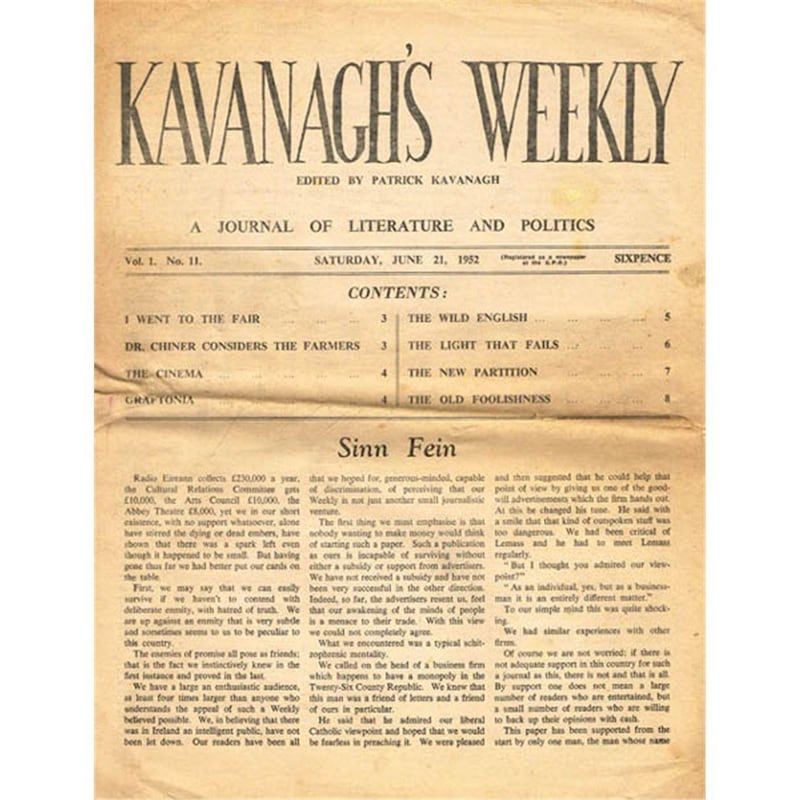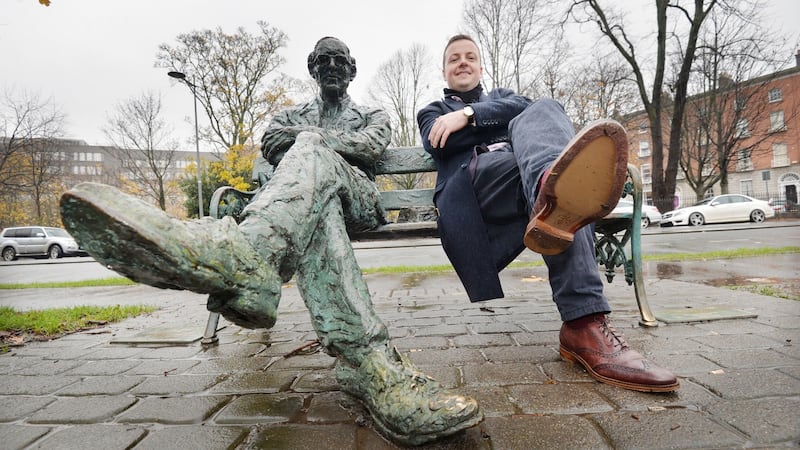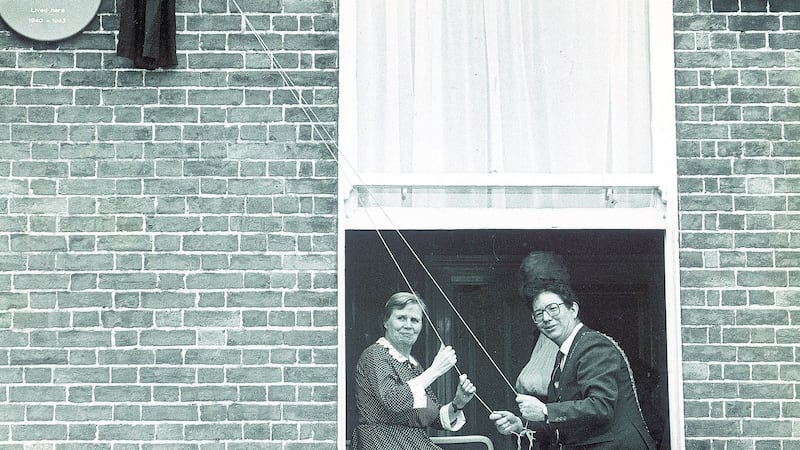It is 1987 and Peter Kavanagh is walking about the Pembroke Road flat he once shared with his brother, for an RTÉ documentary. Patrick has been dead for 20 years. His younger sibling’s skin shows the papyrus-thinness of age, his hair frosted on his bulbous head. He pauses and bows at the cold fireplace, swallowing dryly as he finds a familiar chip on the mantelpiece. “I remember making that chip working on Kavanagh’s Weekly.” He touches the flaw silently, its wrongness attaining a value that no perfect fixture could achieve. Only a Kavanagh could discern such profundity from something so mundane.
“My God, the memories, the memories,” he says in a crackling, erudite voice, still tinged with Inniskeen vowels as broad as a field. It’s a poignant moment and the innocent Monaghan boy is visible for an instant as Peter sways slightly, 71 years weighing heavily on his feet. He tells the camera, “this is the fire where we burned the unsold copies of Kavanagh’s Weekly. We were burning for a week, I think the fire brigade was called. They never saw smoke like it before.” He laughs forlornly as the old summer glimmers in his eyes.

The roaring inferno from the lost copies of Patrick Kavanagh’s 13-week experiment had nothing on the rage contained in its pages. The polemical wrath of the writer tore into the literary, media and political elites of Dublin. In today’s language it was Trumpian in its approach, an attempt to bypass the establishment press by bringing his message directly to the people. One of Kavanagh’s favourite words was “phoney”. He applied it liberally to the ideas of Irish revival, romantic notions of the countryside and everyone who espoused them. He even proposed criminalising phoney journalism. In 1952, Kavanagh was calling out “fake news”, but this was a higher class of trolling.
Moribund venture
In a recording made in 1963, bursting as ever with belief in himself, Patrick explains why he went about the moribund venture. “I had so much to say and as no one would employ me, I had nowhere to say it. Every potential employer said that I was a genius, and therefore unemployable. It was horrid.”

It was an impossible effort, the brothers writing nearly every word, including letters to the editor, designing, laying out and distributing it themselves. They enlisted a small and reluctant printing works on Eccles Place. The wild enterprise also burned a hole £800 wide in Peter’s pocket. The joke in places like McDaid’s and the Palace Bar said it was “like robbing Peter to pay Patrick”. Its front page op-ed was headlined “Victory of Mediocrity” and railed about how “as with sin, mediocrity is never pernicious until we begin to call it statesmanship and sound sense”. Kavanagh’s Weekly was withering in its editorials, but satirical too. He lampooned the fatuities of Sunday newspapers, which he claimed were “doping” readers with fashion competitions, crosswords and stories about actors.
The transcripts of his clashes with future taoiseach John A Costello, the counsel cross-examining him, should be included among his literary works
One of their mock competitions invited readers to suggest commodities which might be made in Ireland for export to America. “These commodities must be outlandish enough to deserve a Government subsidy. The winner will be made managing director of the new State-subsidised factory”. The following week they announced the winning entries as “Recordings of the Irish Constitution, Brogues and Clogs, Compressed turf smoke and Mushroom complete with Leprechaun”. The “phoney representation of Ireland” abroad was a bugbear of Kavanagh’s. He also felt lesser talents were celebrated and rewarded by safe establishment types sitting on the Arts Council or the Cultural Relations Committee.

In comedic reviews under the heading “The Wireless” he describes listening to a debate on libraries “with Seán O’Faolain in the chair whose job seemed to be to prevent the debate from getting too interesting”. Radio Éireann was “The National Bucklep” and “a useless branch of the sub-Civil Service where a large number of people lie low and draw their salaries”.
Witty 10-point plan
Some of his broadsides feel contemporary. On a list of 32 items detailing “What’s wrong with Ireland?” he includes “The inferiority complex displayed towards English and American visitors; The lack of leadership in the Labour Party; The Radio Éireann announcers with the ersatz English accent”. In the fourth week the front page asks “What is truth?” and Kavanagh writes a witty 10-point plan to save the country. “Reduce the Civil Service to one-tenth its present size,” he says. “Make lying, sensational journalism a criminal offence,” and “Use Radio Éireann’s £230,000 to spread enlightenment or to drain some of our bogs”. The latter point is starkly similar to Trump’s metaphorical draining of swamps.
He continually fought against the Dublin scene’s efforts to label him as nothing more than a bogman poet. Kavanagh’s Weekly is a triumphant rant with comic flashes that shows a man with more to him than the rural angst of his poetry. It was in ways an extension of the satirising poetry of The Paddiad and his 1951 poem Prelude, written when paying work began to dry up:
Card-sharpers of the art committees
Working all the provincial cities,
They cry ‘Eccentric’ if they hear
A voice that sounds at all sincere.
Fold up their table and their gear
And with the money disappear.
The fallout from Kavanagh’s Weekly was a quasi-accurate profile of him in the Leader, a small but respected journal. It portrayed the writer drinking heavily in bars surrounded by paying admirers whom he insults to a height with a voice like “a load of gravel sliding down the side of a quarry”. The savagery of his weeklies was being avenged. As he told John Montague, “satire is a double-edged sword; it cuts the hand that uses it”. He foolishly brought a libel action against the Leader that lasted three weeks and hit the front pages of The Irish Times, drawing huge crowds to the Four Courts.
The transcripts of his clashes with future taoiseach John A Costello, the counsel cross-examining him, should be included among his literary works. It reads like a fascinating and funny etymology of terms like “gurrier,” “bucklepper”, “firbolg” and “wan”. Kavanagh spectacularly lost the trial on an issue unrelated to the case, when he hysterically denied that he was friendly with Brendan Behan. A copy of Tarry Flynn he had signed for Behan was produced in court, with the words “For Brendan, poet and painter, on the day he decorated my flat...” in Kavanagh’s hand. His nemesis had haunted him again and the Monaghan man was discredited before the jury.
Control of whiskey
By now, as Anthony Cronin put it, Kavanagh was slipping under the control of whiskey with “fistfuls of barbiturates” fuelling a “persecution complex”. The trial loss was followed by a diagnosis of cancer. He had a lung removed. It was his Dublin nadir.
The late marriage left his estate in turmoil as Peter, the 'sacred keeper', fought his sister-in-law in a joint dance of destruction that saw Kavanagh's work left out of important anthologies
Dejected, lonely and broke, he wrote of 1954 that he was “groping in madness under a low sky”. Despite turning 50 in ill-health and despair, Kavanagh was about to produce perhaps his finest work. The Canal poems were written in 1957 and completed his legacy as the greatest Irish poet since Yeats. Canal Bank Walk sang of “leafy with love banks and the green waters of the canal Pouring redemption for me…” while its companion poem evokes death. “O commemorate me where there is water…” Born-again Kavanagh was more self-aware and his poetic satire turned on his own caricature in If Ever You Go to Dublin Town and The Same Again.

Although a descent into roiling tendrils of whiskey “large ones” and gambling stifled output in his final decade, he achieved some of the stability he hankered after. He got a stipend with the help of a remorseful taoiseach Costello, and married Katherine Moloney. Ever the contradiction, he was feted with documentaries, BBC recordings, and cheered by young poets Heaney, Kennelly and Durcan, but still felt unloved. A fortnight before he died, he was removed by a steward from the VIP seats at the launch of the Wolfe Tone monument on Stephen’s Green. He wept at home on Waterloo Road afterwards. One of those who tried to help him that day, a young minister called Haughey, may have thought of the poet when he introduced the Artists Exemption shortly after his death.
The 100th anniversary of his birth in 2004 was marked with Presidential speeches and an evening at the National Concert Hall. It was a typically Official-Ireland, sanitised celebration, devoid of awkward truths about the source of Kavanagh’s rage. Mercifully there are no such events this week by the modern incarnations of the arts committees and boards he so despised. His life ended as it was lived, in chaos. The late marriage left his estate in turmoil as Peter, the “sacred keeper”, fought his sister-in-law in a joint dance of destruction that saw Kavanagh’s work left out of important anthologies. There was even an unseemly row over his grave. Perhaps it might have been better had Patrick been cremated, an unsold soul joining the same magnificent curlicues of fury that fate brought to Kavanagh’s Weekly.
Oliver Callan, creator of Callan’s Kicks and Nob Nation, is a satirist, columnist and impressionist












